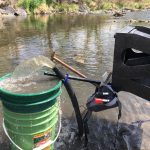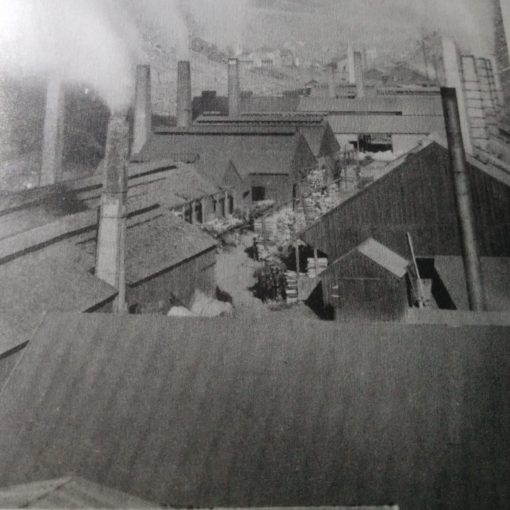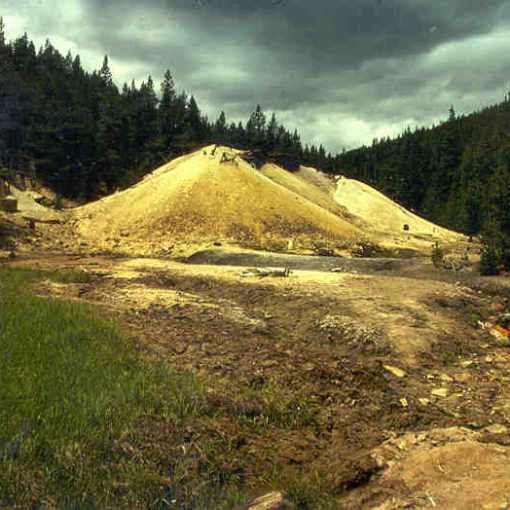The Gold Cube is absolutely a standout product for us small scale gold prospectors in Colorado. Our beautiful state is known for having fine gold that prospectors back in the gold rush found frustrating. This makes the Cube an ideal tool for the serious prospectors who want to move up from pans and stream sluices. In fact, there are two situations where I strongly recommend it as the best choice. The first use is in the field where it catches fine gold more completely than other high bankers. It has become famous for this. The second is to process concentrates from a dredge or other operation that produces a lot of concentrates. In this scenario it will make quick work of your dirt, getting you down to less than a panful in mere moments.
Side Note: As a affiliate marketer I get fees if you buy certain products through my website. I ONLY recommend things I’ve used extensively and love. If you like the info here, please do buy through the links here, it’s the only thing that covers the costs of running the site and it won’t cost you any extra.
First, it makes an outstanding high-banking setup. The biggest problem with most high bankers is retention of fine gold…its dismaying how much fine gold most high bankers lose. If you talk with owners of traditional high bankers you will get into whole discussions about water flow rates, sluice angles, various mats to line the sluices, etc. Of course, everyone will swear that after a lot of fine tuning and fiddling around, they have it worked out. Mostly they don’t. The Gold Cube has this problem beat completely and is famous for its fine gold retention.
Maximum throughput and ability to run a little bit away from a stream (or in a stream where you can’t set up a stream sluice) are the big reasons people buy high bankers in general. The Gold Cube does all this and more- due to its relatively low water needs, it can also be set up as a water recirculation operation for places with limited or no water.
There are three levels of Gold Cube operation in the field. Before you buy, you should think about which configuration makes sense for you:
- The base model 3 Stack Deluxe Gold Cube requires you to use an 8-mesh classifier which is fine (did you notice the pun there? LoL) and I have certainly spent productive days that way. Classifying into a bucket is a good idea if you have to haul material from the dig site to the Gold Cube for some reason. That way you aren’t hauling rocks that you will just toss aside anyway. This is the lowest cost Cube configuration and usually the best setup if you are recirculating your water as well. Another advantage of this configuration is that you know how much material you have processed, just count the buckets as you go…about 20 5-gallon buckets makes a ton! The Gold Cube can handle 10 full 5-gallon buckets per hour. I challenge anyone to produce that much classified material
 that fast!
that fast! - By adding the banker on top, you can put aside the classifier and just shovel directly onto the banker which sits on top of the Gold Cube. This method is better if you have two people working: one to shovel and one to move material off of the punch plate on the banker. Take turns as you go and you can maintain quite a pace of processing (but don’t overdo it, pace yourself as well as avoiding overfeeding). I can tell you this sort of teamwork makes for a fun day!

- Go big and add the trommel to the Gold Cube and you have something that seems like magic to those of us who like to DIG! Just setup right next to your paydirt, shovel into the hopper and the trommel does the rest. It will spit out rocks up to three inches in diameter and you can just pick the bigger ones out of the hopper as you go. The trommel cleans the rocks really well and will take your one-person production up to the maximum level. To see a one-person operation, watch this video of my friend Tim running his trommel for the very first time at Big Bend in Denver (and please subscribe to his YouTube channel!) https://m.youtube.com/watch?feature=youtu.be&v=DD9gjgwccpU With this setup every other prospector you meet will be jealous of you 🙂 I especially like using my trommel when I am working alone and there is a lot of sticky material in my paydirt. The trommel does a great job of dissolving the sticky stuff.
Whichever configuration you choose, take co-inventor Mike Pung’s advice on how to set up your electric connections https://www.facebook.com/100002846087590/posts/2559689284135916/?
Second, to process concentrates after a day of dredging you have a couple options:
- Set up your Gold Cube on site and process your concentrates down to about 1.5 cups of material in mere moments. So little to pack up and carry home! I’m told this is what Parker Schnabel does with the concentrates from his giant sluices that you see on the GOLD RUSH TV show.
- Take the concentrates home and run the cube in the driveway. Already getting cold and dark when you get dragged out of the water by your prospecting buddies? Then this is for you.
Either way you will end up with all the fine gold captured and just 1.5 cups of material to pan out. A big improvement over that whole bucket of material you usually come home with, right? See link below this article for my advice on concentrate processing.
Are you a fan of Dream Mat or Gold Hog mats or some other brand? It’s now easy to build a Gold Cube with a mix of brands of mats. Just buy the mat you like, call 1-800-649-0256 to order the new “mat hold-down system” and a blank tray to put it into. Be sure to tell them I sent you since the hold-down is not on the website yet! Here’s a YouTube video from Mike at Gold Cube showing how to install and use it. by the way, I now run my Cube with a skid plate, a Dream Mat and two trays of original vortex mat. This combo seems to work well for me. Maybe you should try something similar!
Whichever setup you choose, here are a few tips from my own experience:
- Start with a light weight, high-capacity lithium battery such as this one which is just as affordable as a deep cycle lead acid battery but at 1/3 the weight! That’s the one I use for all my battery powered gear. Most likely, it’ll have FAR more capacity than you ever need and its warrantied to last 5000 charging cycles.
- Carry and use your batteries in a battery box or bucket with a foam pad or cloth at the bottom. It really sucks to drop a battery, as you hike in, if the battery case cracks. Major fail. Don’t ask how I know this 😉 This strategy also avoids an acid spill which might make the local rangers grumpy!
- Handcarts and/or plastic totes make getting the cube to the dig site easier. I use a plastic tote.
- When you are setting up, set up the pump and battery first. Then use water flow from the pump hose and a vegetable brush to thoroughly wet the trays as you set up the sluice. Your goal here is to get rid of the bubbles in each vortex mat before you start running dirt.
- When you are working, keep the pump running until it is time to clean up. Turning off and on multiple times may save a little battery life but it risks having the gold dry out in the sluice. Dry gold floats away…catch and release is NOT our plan! (Note: Despite this official advice, folks say you can turn the pump off “while you have lunch” with no detected gold losses. So maybe this rule isn’t really a concern 🙂 although it’s what many say. Also see Mike Pung’s comment on this below.
- When you clean up, disconnect the hose from the top tray and take a pic of the pretty gold in that top sluice tray to show your friends. Then as you pull each tray, use the water from your pump hose to rinse the trays into your washout tub. Quick and simple!
- Go to the hardware store and buy a few extra thumb screws. They have a way of disappearing and it’s funny how hard it is to make a cube stand work with only 3 thumbscrews to hold the frame on the legs. Ok, it’s not funny, it’ll spoil your day. All for lack of a 20-cent thumb screw!
- Speaking of losing things, get some florescent paint, assemble your stand, then squirt the thumb screws and the ends of each leg with that bright paint. Now they can’t hide amongst the rocks in the creek bed! (Let dry before disassembly…painting while assembled prevents paint from coating threads, nobody wants that!)
- Try using your pump and hose to help wash rocks in the classifiers like this:

Ad hoc rock washer
Want to learn more about why and how the Gold Cube catches gold so well? The gold cube uses Trev Alty’s Treatise of gravity columns: https://www.treasurenet.com/threads/gold-cube-a-bit-of-the-history.475010/
The links in the text of this article connect you directly to my friends at Gold Cube via their website. If you’d rather buy through Amazon (maybe you have a gift card?!) you can do that here or more specifically here.
Need to know what to do with the concentrates after you are done running your Gold Cube? Check out this article: https://findinggoldincolorado.com/finish-processing-your-concentrates-after-a-day-of-digging/
Here’s a spot in north Denver where the Gold Cube is by far the best tool. Great gold and nowhere to set up a sluice: https://findinggoldincolorado.com/dudleys-bar-prospecting-tips-that-area/If you want more spots; I suggest my gold prospecting guidebook Finding Gold in Colorado: Prospector’s Edition (here) with over 180 public access dig sites across Colorado Gold Country.
* * * * * * update 5/22/18 * * * * * *
In a recent series of comment shows on the Facebook group, Gold Cube CO-inventor Mike Pung shared some more tips. Here’s what he said:
– If you turn the pump off and on, put a pan under the Cube discharge for a slow count of 5 seconds. Pan it out to see if anything escaped or just dump it back on the top feed deck.
– Pre-wet any dry material before feeding it into the Gold Cube or use a vibrating feeder. Otherwise, dry material can ride through the Cube in an air bubble.
– If you do a mid-day clean up, just clean out the top vortex tray. Once clean, put it on the bottom of the stack of trays.
– If organic material is collecting on the vortex tray, use a hairbrush or dish scrub brush to sweep it clear. Be sure to pan the stuff the hairbrush removes.
– When in a new area, monitor your bottom tray for gold. When 10% of your gold is getting caught on the bottom tray, it’s clean out time. To run longer, get another tray to add to the stack.
– on the topic of which size pump to use for your setup:
There is a lot of things that can affect the amount of water that is available to do the job. Head pressure is caused by the amount of lift you are asking the pump to push, the higher the lift the lower GPH you will have to do the job, so I try to keep the whole system as close to the water level as possible. If you are trying to capture your tailings in a 5-gallon bucket, you are way too high and the increase in elevation has lowered your GPH to a point of either needing to slow down your feed rate or risk gold flowing right over your stalled vortex mat. A good indication that you have too little water is the G-force trough will be collecting material. The other things that will affect water flow will be if the pump screen or impeller has debris or the battery is weak.
A 2000 gph pump is never recommended for a straight shot into the Cube. But the Banker and the Trommel have spray-bars and also a higher lift (ed: they also lose some water with the oversized rocks going into the tailings). These flow limiting conditions require more water to be added to do the job. The 2000 gph pump we sell is about right but to check your system out after you get it set up, use the dowel rod method to measure max flow.
1. a 5/8″ dowel rod to 10 inches.
2. Roll the dowel down the water tray slick plate and it will jamb and dam up the water all but an inch on either side.
3. With the water on, you will see the water getting deep above the dowel.
4. Watch the scooped-out section of the plastic that forms the Cube side openings, the water should not overflow out those sides. If it stays contained, you are good, if it overflows, you need to dial back the water.
5. As with any new area or any new set-up, the proof of the pudding is in the taste. Run 30 min, check your tailings and check each tray to see how far your gold is getting. If the water is correct, and the bubbles are out of the mat, you will see what is expected, most of your gold will be in the beginning of the first mat with little to no gold in the lower trays or in the tailings. If you seem to have a little too much gold on the second matted tray, you may need to slow your water down just a little. (Ed: Easy ways to do this include raising the cube so the pump has to push higher or using a longer hose.)
– the official Gold Cube key chain makes a great tool for tightening and loosening the thumb screws on your cube stand
– the 1,000 pound per hour capacity of the cube means it’ll process about 10 five-gallon buckets of eight-mesh classified paydirt per hour. That’s a lot if you are digging alone but don’t overfeed your cube as it leads to gold loss. (Ed. Having learned this, I now do things differently since I use the Gold Banker and usually shovel like a fiend: I fill a bucket with unclassified material (which takes about 6 shovelfuls), then classify it to figure out how many of MY shovelfuls per hour I can feed. Often, it’s about 12 unclassified shovels to fill a bucket with classified material. That comes out to one shovelful on the Banker every 30 seconds as my maximum feed speed.)
Thanks for the tips, Mike!
- Here’s an article from my friend Tom Farley where he explains the best way to connect the pump wires to the battery clamps. Doing it his way will save you some hassles in the field: www.southwestrockhounding.com/2020/01/29/the-gold-cube-part-one/?
****** 3/28/2021 more tips from Mike! ******
All dirt and gold by size and shape will make every mining situation a little different. When I am in a new area, I do a clean-up after about an hour. I clean the first tray and I clean the last tray to see how far the gold is getting. Beach mining will have constant migration because the gold is all in black sands, very small gold and very heavy sands! But on a river or any other situation where you are actually in sands and gravels, you will be checking to see that the bottom tray has less than 10% of the gold yield. In most cases, after an hour there will be less that 1% and then you know you will be able to run until you just feel like a clean-up to give you a break. If there is more than 10% then you need to clean up more often or get another tray. Also if gold is too far down the system, you might have bubbles trapped in the mat, or over feeding the system. If you can’t see the mat, the gold can’t either. Oh and to answer the question on how many buckets???? As few as 1 and as many as 200 – Let your material and gold tell you.








13 thoughts on “Using a Gold Cube”
Thanks for the info. Just got me a gold cube and I’m open to any and all tips and tricks to help me learn it’s quirks.
I love my cube so much i bought another one with the trommel. Best tool ever!
Wow!
Ever try stacking all the trays into one giant cube? I’ve seen video of Mike Ping running a tall stack on a beach somewhere. I’d be curious to learn what gets caught in the bottom trays when you go 6 or more trays high!
so – where do I go to get gold dredging, high banking regulations, licensing in Colorado? i.e. I have been told state water board permit is necessary to do dredging even with a vacuum dredge.
Hi Donald, the state of Colorado allows the use of power equipment with nozzles up to 4 inch diameter with no licensing or paperwork requirements. So that box is checked. Lots of prospectors use gas powered suction pump based systems here.
Your next step is still to check with the agency managing the land of course. This means contacting the local BLM or Forest Service office just as you would anywhere else to confirm local restrictions if any. All of this assumes you are on federally managed public land of course. For state or locally managed lands you’d start with those entities.
If you have a specific area of the state you are interested in I can help you find the right folks to talk to.
Hi Kevin,
How long does the battery you recommend actually power the trommel and pump?
That battery will run the Cube (without a Trommel) for several hours of operating time. Enough that I haven’t needed a second battery even though I always carry two.
However when I’ve run a trommel it has always been with a full sized deep cycle marine battery (it’s a friend’s setup) so I don’t know how long the smaller battery would hold up. If you try it, let me know!
Thank you for this website Kevin. I Just ordered a copy of your book. Saw Mike’s presentation at the Denver Mineral Show in 2012, and bought a cube from him right at the show. We are returning to CO this summer, can you tell me if there are any restrictions to using the Cube in Colorado? Is it considered ‘mechanicized’? Is it considered a highbanker? Do you know if I could use at Cache Creek? Thank you for your help in answering these questions.
Hi Jeff. Yes a cube is mechanized (moving parts) so no you can’t use it at Cache Creek. However, there are MANY places you can use it. My book covers locations and rules quite extensively; do you have the book?
you say nothing about levelling the cube at setup???
Hmm, good point. Level your cube before use. Front to back and side to side both. Front to back is ok +/- 2 degrees. Side to side is more crucial to get right but can be judged by eyeballing the water flow across the mats. – Kevin
Good stuff Tom!